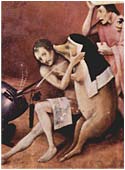


Animals as Lovers and Dogs as Witnesses: Renaissance Measures Against Bestiality
During the Renaissance, European governments stepped up repression against "sodomy," a catch-all category of sin that could include everything from witchcraft to adventurous sex between husbands and wives. Intimate relations between people and animals was also included in the crime, as shown by the following cases in Geneva, France, Massachusetts, and Scotland:
Sodomy prosecutions in Geneva focused on cases involving bestiality. Sex with animals was seen as a violation of biblical edicts and, especially when goats were involved, a link to witchcraft. Most jurisdictions had laws on the books condemning bestiality, and these were vigorously enforced. "There is hardly a tribunal in Europe which has not condemned to the fire some miserable ones convicted of this turpitude," Voltaire would later write, although the great philosopher and snob added, rather too carefully: "Young peasants... are alone guilty of this infamy and... scarcely differ from the animals with which they couple."
In 1601, a sixteen-year-old French girl named Claudine de Culam was charged for carnally knowing a dog, although she passionately denied the accusation. The court came up with an innovative method for revealing the truth. The girl and the dog were taken to a chamber adjacent to the courtroom, where Claudine was told to undress. The dog immediately leaped up and attempted copulation with her, "which he would perhaps have accomplished had we not prevented him." Both Claudine and the animal were strangled and their bodies burned. Their ashes were "thrown to the winds" to leave no trace of them or their crimes. The execution of animals along with their human lovers was common. Also in France, in 1606, a dog that had scampered away after suffering sexual indignities with a human was condemned and hanged in effigy. A few decades later, in Britain's Massachusetts Bay Colony, a teenage boy who was put under arrest was forced to reveal all his sexual partners. The list included a mare, a cow, two goats, two calves, five sheep, and a turkey. The animals were all killed and their carcasses thrown away, and the boy went to the gallows. Occasionally, European courts gave animals the right to confess their crimes, though this took some rather harsh prodding. Their squeals in pain while being held over fires were taken as admissions of guilt.
1 2